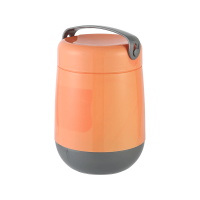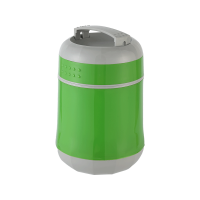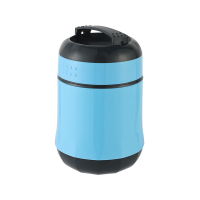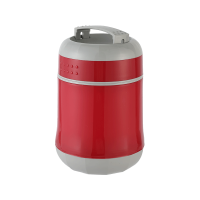Our main products include coffee vacuum jugs, airpot, thermos bottles, food containers, travel pots, sports kettles, and other varieties of insulated utensils, and constantly introduce new styles to cater to the market. Our products come with novel designs, excellent finishing, and great insulation performance, safe, portable, fashionable, and beautiful. It can also be customized to a variety of specifications and functions.
With an area of 20,000 square meters, the company is equipped with advanced manufacturing technology and other high-tech equipment, more than 200 staff including 20+ technical personnel and 5 engineers. The company manages its mold factory and a complete production line to fulfill a daily production capacity of 10,000. Kesihao continuously invests in product research, development, and innovation. The factory introduced a complete modern management system and implemented strict quality control and 5S site management. We actively introduce and practice international advanced management mode. The factory has passed BSCI and ISO9001 quality management systems.
With an area of 20,000 square meters, the company is equipped with advanced manufacturing technology and other high-tech equipment, more than 200 staff including 20+ technical personnel and 5 engineers. The company manages its mold factory and a complete production line to fulfill a daily production capacity of 10,000. Kesihao continuously invests in product research, development, and innovation. The factory introduced a complete modern management system and implemented strict quality control and 5S site management. We actively introduce and practice international advanced management mode. The factory has passed BSCI and ISO9001 quality management systems.
Kesihao is surrounded by a team of hard-working and reliable professionals. Our team values positivity, initiative, and creativity. With a common passion to create the best products for the customers, we offer each team member maximum freedom to develop themselves and we are offering consistent support along their journey.
Now we are promoting our own brand Soopot, with a mission to provide each customer with high-quality products and services. All products are made with consistently proven quality at a competitive price. Customer is always our top priority. We strive to help every user to achieve energy saving, healthy, convenient, and quality life. Let’s work together to shape a better future.
KSH-H2510P/H2514P 1.0L/1.4L Plastic Food Container
Introduction:
- Reference
- Cautions
- Specification
- About
| Picture |  |
 |
 |
 |
 |
 |
|
| Item No. | KSH-H2510P | KSH-H2514P | |||||
| Item Volume | 1.0L | 1.4L | |||||
| Item Dimensions (L; W; H) | 235*155*155 | ||||||
| Item Weight(g) | 508.2 | 627 | 483.4 | ||||
| Outer Carton | Pcs per Master | 12 | 12 | ||||
| Length (cm) | 62 | 64 | |||||
| Width (cm) | 46.5 | 48 | |||||
| Height (cm) | 23 | 25 | |||||
| Net Weight (kg) | 5.8 | 6 | |||||
| Gross Weight (kg) | 6.8 | 7 | |||||
| Master volume (CBM) | 0.066 | 0.077 | |||||
| Color Box | Length (mm) | 15.7 | |||||
| Width (mm) | 15.6 | ||||||
| Height (mm) | 24 | ||||||
| CONTAINER LOADING CAPACITY | 20GP | 4705 | 4063 | ||||
| 40GP | 9772 | 8438 | |||||
| 40HQ | 11944 | 10313 | |||||
Our main products include coffee vacuum jugs, air pots, thermos bottles, food containers, travel pots, sports kettles, and other varieties of insulated utensils, and constantly introduce new styles to cater to the market. Our products come with novel designs, excellent finishing, and great insulation performance, safe, portable, fashionable, and beautiful. It can also be customized to a variety of specifications and functions.
With an area of 20,000 square meters, the company is equipped with advanced manufacturing technology and other high-tech equipment, more than 200 staff including 20+ technical personnel and 5 engineers. The company manages its mold factory and a complete production line to fulfill a daily production capacity of 10,000. Kesihao continuously invests in product research, development, and innovation. The factory introduced a complete modern management system and implemented strict quality control and 5S site management. We actively introduce and practice international advanced management mode. The factory has passed BSCI and ISO9001 quality management systems.
Kesihao is surrounded by a team of hard-working and reliable professionals. Our team values positivity, initiative, and creativity. With a common passion to create the best products for the customers, we offer each team member maximum freedom to develop themselves and we are offering consistent support along their journey.
Now we are promoting our own brand Soopot, with a mission to provide each customer with high-quality products and services. All products are made with consistently proven quality at a competitive price. Customer is always our top priority. We strive to help every user to achieve energy saving, healthy, convenient, and quality life.
Let’s work together to shape a better future.
Contact Us
Taizhou Kesihao Trading Co., Ltd.
Hot Products
-

KSH-S910 1.0L Glass Liner Stainless Steel Body Airpot Dispenser
-

KSH-H910 1.0L Pink Glass/Glass Liner Plastic Body Airpot Dispenser
-

KSH-S719 1.9L Glass Liner Stainless Steel Body Airpot Dispenser
-

KSH-S925 2.5L Pink Glass Liner Metal Body Airpot Dispenser
-

KSH-HS1595 9.5L Insulated Water Jug
-

KSH-S190 1.9L Glass Liner Metal Body Airpot Dispenser
-

KSH-S525 2.5L Pink Glass Liner Stainless Steel Body Airpot Dispenser
-

KSH-S816 1.6L Pink Glass Liner Metal Bady Vacuum Jug
-

KSH-S816 1.6L Pink Glass Liner Metal Bady Vacuum Jug
-

KSH-S819 1.9L Pink Glass Liner Metal Bady Vacuum Jug
-

KSH-S813 1.3L Pink Glass Liner Metal Bady Vacuum Jug
-

KSH-66T100 1.0L/1.8L Glass Liner Plastic Body Vacuum Flask
Latest News
-
Apr , 18 , 2025
Why Vacuum Jugs Are Revolutionizing Beverage Storage?
Sale vacuum ceramic thermal flask jugs Factory In a world where convenience and efficiency are key, ... -
Apr , 11 , 2025
The Essential Convenience of the Coffee Shaker Bottle
Custom Coffee Shaker Cup Manufacturer In today’s fast-paced world, where convenience and efficiency ... -
Apr , 04 , 2025
The Power of Industrial Thermos Flasks
Custom industrial thermos thermal jug flasks Manufacturer In today’s fast-paced industrial world, ef... -
Mar , 28 , 2025
How to Choose the Right Coffee Shaker?
Wholesale Coffee Collapsible Shaker Bottle Manufacturer In the bustling world of on-the-go coffee co... -
Mar , 21 , 2025
The Rise of the Coffee Shaker Bottle in Sports Nutrition
Sale Coffee Cold Shaker Bottle Company In today’s health-conscious world, the Coffee Shaker Bottle h... -
Mar , 14 , 2025
The Coffee Shaker Bottle: Your Ultimate Companion for On-the-Go Brewing and Beyond
Custom Coffee Fitness Shaker Bottle Factory In today's fast-paced world, where every minute counts, ...
How is the growing demand for 1.4L plastic food containers impacting the packaging industry?
The increasing demand for 1.4L plastic food containers is significantly influencing the packaging industry. This size of food container has gained popularity due to its versatility, convenience, and suitability for various food products.
1. Market Growth and Revenue:
The rising demand for 1.4L plastic food containers is driving the growth of the packaging industry. Manufacturers are witnessing increased production and sales of these containers, leading to higher revenue generation. As more consumers rely on pre-packaged meals and convenience foods, the demand for appropriately sized containers continues to surge.
2. Technological Advancements:
To meet the market demand, packaging companies are investing in advanced technologies. Innovations in plastic molding techniques, such as injection molding and blow molding, enable efficient mass production of 1.4L food containers. These advancements allow manufacturers to optimize production processes, reduce costs, and enhance the overall quality of the containers.
3. Sustainability Challenges:
While the demand for 1.4L plastic food containers is growing, the industry is also facing sustainability concerns. Plastic waste and its impact on the environment have become significant global issues. As a result, manufacturers are under pressure to develop more sustainable packaging alternatives, such as biodegradable or compostable materials. Finding a balance between convenience and environmental responsibility remains a challenge for the industry.
4. Regulations and Compliance:
The increased usage of plastic food containers has prompted governments and regulatory bodies to implement stricter guidelines and regulations. These measures aim to address the environmental impact of plastic waste and promote sustainable packaging practices. Packaging companies need to stay updated with these regulations to ensure compliance and avoid penalties, while also adapting their manufacturing processes and materials accordingly.
5. Consumer Preferences and Convenience:
Consumers' preferences and lifestyles play a vital role in shaping the demand for 1.4L plastic food containers. Today's busy lifestyles often require convenient, on-the-go food options. The 1.4L size offers an ideal portion for single servings or smaller meals, making it attractive to consumers seeking quick and easy meal solutions. Packaging companies must continuously monitor consumer trends and preferences to stay competitive in the market.
6. Branding and Design Opportunities:
The demand for 1.4L plastic food containers also presents branding and design opportunities for packaging companies. Customizable packaging allows brands to differentiate their products and create a unique identity in the market. Eye-catching designs, labels, and logos can enhance product visibility and attract consumers amidst a sea of options. This aspect opens up avenues for collaboration between packaging companies and food brands to create appealing and functional packaging solutions.
How can the design and features of 1.4L plastic food containers be optimized to meet the evolving needs of consumers and address sustainability concerns?
Designing and optimizing 1.4L plastic food containers to meet the changing needs of consumers while addressing sustainability concerns is a crucial challenge for the packaging industry. Let's explore various strategies and features that can be implemented to achieve these goals.
1. Material Selection:
One of the key considerations in optimizing 1.4L plastic food containers is the choice of materials. To address sustainability concerns, manufacturers can explore alternatives to traditional petroleum-based plastics. Biodegradable or compostable materials derived from renewable sources, such as plant-based plastics or bio-polymers, can be utilized. These materials offer reduced environmental impact and help minimize plastic waste.
2. Lightweight Design:
Efforts should be made to reduce the overall weight of 1.4L plastic food containers while maintaining their structural integrity. Lighter containers require less raw material and energy for production, resulting in reduced carbon emissions and lower transportation costs. Additionally, lightweight containers are more convenient for consumers and contribute to a positive user experience.
3. Portion Control and Versatility:
The design of 1.4L plastic food containers should prioritize portion control and versatility. Incorporating segmented compartments or adjustable dividers allows consumers to conveniently separate different food items within a single container. This feature promotes portion control, reduces food waste, and caters to the increasing demand for pre-portioned and well-balanced meals.
4. Microwave and Freezer Safe:
Consumers often seek convenience in their food containers. Designing 1.4L plastic food containers to be microwave and freezer safe enhances their functionality. It allows consumers to conveniently heat or cool their meals without the need for transferring food to separate dishes, thus saving time and reducing dishwashing. Microwave and freezer-safe containers also encourage consumers to use reusable containers instead of disposable options.
5. Leak-Proof and Secure Sealing:
To ensure consumer satisfaction and prevent food spillage, the design of 1.4L plastic food containers should incorporate leak-proof and secure sealing mechanisms. This feature ensures that liquids and semi-liquid foods can be stored and transported safely without the risk of leakage. A reliable sealing system enhances the convenience and usability of the containers, making them suitable for a wide range of food items.
6. Stackability and Space Efficiency:
Space efficiency is an essential consideration for both consumers and manufacturers. Designing 1.4L plastic food containers with a stackable design enables efficient storage in kitchens, refrigerators, and retail shelves. This feature optimizes space utilization, streamlines logistics, and reduces packaging waste during transportation.
7. Transparent and Recyclable Packaging:
Clear and transparent packaging allows consumers to easily identify the contents of 1.4L plastic food containers, enhancing their convenience and aiding in food management. Moreover, ensuring that the packaging is recyclable and prominently displaying recycling symbols encourages consumers to dispose of the containers responsibly. Clear instructions on proper recycling methods can further promote sustainable practices.
8. Ergonomic Design and Grips:
Comfortable and ergonomic design elements, such as textured grips and easy-to-hold shapes, contribute to the usability and consumer experience of 1.4L plastic food containers. These features improve handling and reduce the risk of accidents, making the containers more user-friendly and appealing to a wide range of consumers.
 Get A Quote
Get A Quote
 English
English عربى
عربى 中文简体
中文简体





















 Add: No. 7 Kangqiang Road, Beicheng Street, Taizhou City, Zhejiang Province
Add: No. 7 Kangqiang Road, Beicheng Street, Taizhou City, Zhejiang Province Tel: +86-13857600804
Tel: +86-13857600804 Email:
Email: